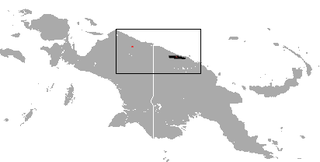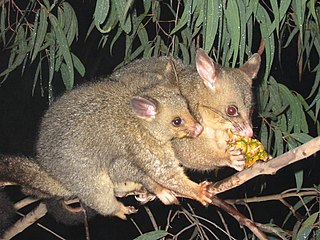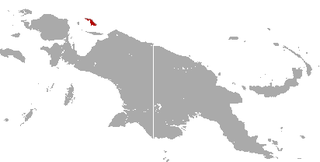
Phalangeriformes is a paraphyletic suborder of about 70 species of small to medium-sized arboreal marsupials native to Australia, New Guinea, and Sulawesi. The species are commonly known as possums, gliders, and cuscus. The common name "possum" for various Phalangeriformes species derives from the creatures' resemblance to the opossums of the Americas. However, although opossums are also marsupials, Australasian possums are more closely related to other Australasian marsupials such as kangaroos.

The common echymipera, or common spiny bandicoot, is a bandicoot. It is long-snouted even by bandicoot standards. The upper parts are a coarse reddish-brown, flecked with spiny buff and black hairs. The tail is short and almost hairless. Length varies between 30 and 40 cm, with the tail accounting for an additional 8 to 10 cm ; the weight is from 0.6 to 2 kg.

The common spotted cuscus, also known as the white cuscus, is a cuscus, a marsupial that lives in the Cape York region of Australia, New Guinea, and nearby smaller islands.

Phalanger is a genus of possums. Its members are found on New Guinea, the Maluku Islands, other nearby small islands, and Australia's Cape York Peninsula. They are marsupials of the family Phalangeridae, and are one of the four genera whose species are commonly referred to as cuscuses.

The golden-mantled tree-kangaroo is a critically endangered, furry, bear-like mammal found only in mountain rain forests on the island of New Guinea. Like other tree-kangaroos, it lives in trees and feeds on plant matter. It belongs to the macropod family (Macropodidae) with kangaroos, and carries its young in a pouch like other marsupials. The range is restricted to two small mountain areas in the north and it is threatened by hunting and habitat loss.

The black dorcopsis or black forest wallaby is a species of marsupial in the family Macropodidae. It is endemic to an island at the eastern end of New Guinea where its natural habitat is subtropical or tropical dry forests. It is threatened by habitat loss and hunting, its population is declining and the IUCN lists it as being "Critically endangered".

The mountain cuscus is a species of marsupial in the family Phalangeridae found in West Papua, Indonesia and Papua New Guinea.

The ground cuscus is a marsupial from the order Diprotodontia and belongs within the family Phalangeridae, a diverse family consisting of the other cuscus species and the brushtail possums and the scaly-tailed possum.

The Woodlark cuscus is a species of marsupial in the family Phalangeridae endemic to Papua New Guinea, specifically on Madau and Woodlark Island, a part of the Milne Bay Province of Papua New Guinea. It happens to be the largest mammal living on Woodlark Island but it is also found on the neighboring island of Alcester, 70 kilometers south of Woodlark Island.

The northern common cuscus, also known as the gray cuscus, is a species of marsupial in the family Phalangeridae native to northern New Guinea and adjacent smaller islands, but is now also found in the Bismarck Archipelago, southeast and central Moluccas, the Solomons, and Timor, where it is believed to have been introduced in prehistoric times from New Guinea. It was formerly considered conspecific with the allopatric P. intercastellanus and P. mimicus.

The silky cuscus is a species of marsupial in the family Phalangeridae. It is found in Indonesia and Papua New Guinea.

Stein's cuscus is a species of marsupial in the family Phalangeridae. It is found in Indonesia and Papua New Guinea.

The Admiralty Island cuscus or Manus Island spotted cuscus is a species of marsupial in the family Phalangeridae. It is endemic to the Admiralty Islands of Papua New Guinea. It is the smallest member of the genus Spilocuscus, and the female has a black back, while the male has blackish spots on a white background. Both genders have rufous heads.

Spilocuscus is a genus of marsupial in the family Phalangeridae. Its members are found on the Cape York Peninsula of Australia, New Guinea, and smaller nearby islands. It contains the following species:

The Waigeou cuscus or Waigeou spotted cuscus is a species of marsupial in the family Phalangeridae. It is endemic to the island of Waigeo in Indonesia, and consequently the spelling Waigeo cuscus is often used instead of Waigeou cuscus. Unlike all other members of the genus Spilocuscus, both genders are whitish with black spots. It remains fairly common, but its small range makes it vulnerable to habitat loss and hunting.

The Phalangeridae are a family of mostly nocturnal marsupials native to Australia, New Guinea, and Eastern Indonesia, including the cuscuses, brushtail possums, and their close relatives. Considered a type of possum, most species are arboreal, and they inhabit a wide range of forest habitats from alpine woodland to eucalypt forest and tropical jungle. Many species have been introduced to various non-native habitats by humans for thousands of years.
Cuscus is the common name generally given to the species within the four genera of Australasian possum of the family Phalangeridae with the most tropical distribution:

The blue-eyed spotted cuscus or Biak spotted cuscus is a species of critically endangered marsupial in the family Phalangeridae.


















